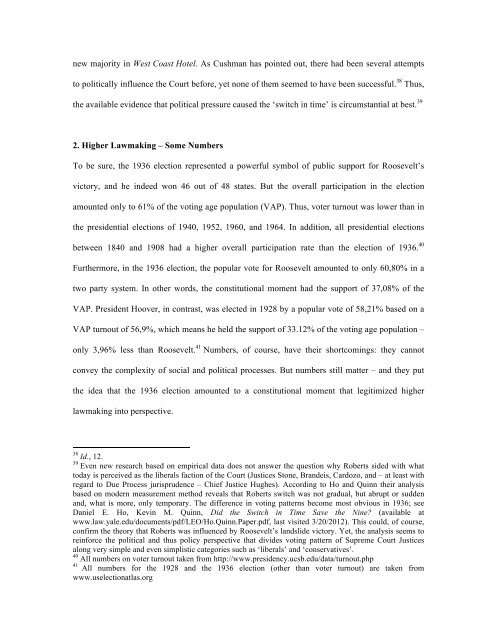Jasper Finke, Crisis and Law - New York University School of Law
Jasper Finke, Crisis and Law - New York University School of Law
Jasper Finke, Crisis and Law - New York University School of Law
You also want an ePaper? Increase the reach of your titles
YUMPU automatically turns print PDFs into web optimized ePapers that Google loves.
new majority in West Coast Hotel. As Cushman has pointed out, there had been several attempts<br />
to politically influence the Court before, yet none <strong>of</strong> them seemed to have been successful. 38 Thus,<br />
the available evidence that political pressure caused the ‘switch in time’ is circumstantial at best. 39<br />
2. Higher <strong>Law</strong>making – Some Numbers<br />
To be sure, the 1936 election represented a powerful symbol <strong>of</strong> public support for Roosevelt’s<br />
victory, <strong>and</strong> he indeed won 46 out <strong>of</strong> 48 states. But the overall participation in the election<br />
amounted only to 61% <strong>of</strong> the voting age population (VAP). Thus, voter turnout was lower than in<br />
the presidential elections <strong>of</strong> 1940, 1952, 1960, <strong>and</strong> 1964. In addition, all presidential elections<br />
between 1840 <strong>and</strong> 1908 had a higher overall participation rate than the election <strong>of</strong> 1936. 40<br />
Furthermore, in the 1936 election, the popular vote for Roosevelt amounted to only 60,80% in a<br />
two party system. In other words, the constitutional moment had the support <strong>of</strong> 37,08% <strong>of</strong> the<br />
VAP. President Hoover, in contrast, was elected in 1928 by a popular vote <strong>of</strong> 58,21% based on a<br />
VAP turnout <strong>of</strong> 56,9%, which means he held the support <strong>of</strong> 33.12% <strong>of</strong> the voting age population –<br />
only 3,96% less than Roosevelt. 41 Numbers, <strong>of</strong> course, have their shortcomings: they cannot<br />
convey the complexity <strong>of</strong> social <strong>and</strong> political processes. But numbers still matter – <strong>and</strong> they put<br />
the idea that the 1936 election amounted to a constitutional moment that legitimized higher<br />
lawmaking into perspective.<br />
38 Id., 12.<br />
39 Even new research based on empirical data does not answer the question why Roberts sided with what<br />
today is perceived as the liberals faction <strong>of</strong> the Court (Justices Stone, Br<strong>and</strong>eis, Cardozo, <strong>and</strong> – at least with<br />
regard to Due Process jurisprudence – Chief Justice Hughes). According to Ho <strong>and</strong> Quinn their analysis<br />
based on modern measurement method reveals that Roberts switch was not gradual, but abrupt or sudden<br />
<strong>and</strong>, what is more, only temporary. The difference in voting patterns become most obvious in 1936; see<br />
Daniel E. Ho, Kevin M. Quinn, Did the Switch in Time Save the Nine? (available at<br />
www.law.yale.edu/documents/pdf/LEO/Ho.Quinn.Paper.pdf, last visited 3/20/2012). This could, <strong>of</strong> course,<br />
confirm the theory that Roberts was influenced by Roosevelt’s l<strong>and</strong>slide victory. Yet, the analysis seems to<br />
reinforce the political <strong>and</strong> thus policy perspective that divides voting pattern <strong>of</strong> Supreme Court Justices<br />
along very simple <strong>and</strong> even simplistic categories such as ‘liberals’ <strong>and</strong> ‘conservatives’.<br />
40 All numbers on voter turnout taken from http://www.presidency.ucsb.edu/data/turnout.php<br />
41 All numbers for the 1928 <strong>and</strong> the 1936 election (other than voter turnout) are taken from<br />
www.uselectionatlas.org
















